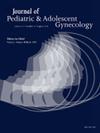22. Clinical and Biochemical Characteristics of Adolescent Females in the United States at Time of PCOS Diagnosis: Results from the CALICO multi-center database
IF 1.7
4区 医学
Q3 OBSTETRICS & GYNECOLOGY
引用次数: 0
Abstract
Background
Adolescents with polycystic ovary syndrome (PCOS) are a heterogeneous population with variable phenotypes. We describe the clinical and biochemical characteristics of a regionally and racially diverse cohort of adolescents, at the time of PCOS diagnosis, in the United States.
Methods
These data derive from the retrospective Clinical Adolescent Polycystic Ovary (CALICO) Database, including data from 15 U.S. sites of adolescents diagnosed with PCOS per 2023 international guidelines. Data from the initial PCOS diagnostic encounter were included. Sample size differs with each variable due to documentation and clinical practice differences across sites. To harmonize differences in hormonal assays, these variables are reported as the percentage of the upper limit of normal (%ULN) for each assay. Data were divided by overweight/obesity status (BMI >85%ile). Continuous variables were compared using linear model ANOVA or t-tests and categorical variables were compared using Pearson's Chi-squared test.
Results
This cohort includes 839 youth from across the U.S. (34.1% from the Southeast, 25.7% from the Midwest, 21% from the West, 16.2% from the Northeast, and 3% from the Southwest) who were of diverse race/ethnicity (65.5% Caucasian, 20.4% Black, 34.5% Hispanic). The median age of menarche was 11.5 years (IQR, 11, 12.5) and median age of PCOS diagnosis was 15.3 years (IQR, 14.2, 16.4). Menstrual patterns included primary amenorrhea in 9.3%, < 21 days between periods in 5.0%, and >45 days between periods in 85.6% of individuals. Hirsutism severity was documented in 48.7% of encounters with 34.4% reporting no hirsutism and 8.3% reporting severe hirsutism. Facial acne severity was documented in 65.4% of encounters with 26.2% reporting mild acne and 6.6% reporting severe acne. Biochemical markers including free and total testosterone, DHEA-S, FSH and LH were assessed in >60% of encounters at time of diagnosis. When stratified by overweight/obese status, those with overweight/obesity had significantly higher free testosterone but lower SHBG, androstenedione and LH. There were no significant differences by weight status in total testosterone, DHEA-S, FSH or AMH (Table 1).
Conclusions
In this study, we characterize the presentation of adolescents at time of PCOS diagnosis in the U.S. with data collected from a geographically, ethnically and racially diverse cohort of individuals. Weight status significantly impacted the levels of some biochemical markers used in the diagnostic evaluation of PCOS.
22. 美国青春期女性多囊卵巢综合征诊断时的临床和生化特征:来自CALICO多中心数据库的结果
背景:青少年多囊卵巢综合征(PCOS)是一个具有不同表型的异质人群。我们描述了一个地区和种族多样化的队列青少年的临床和生化特征,在多囊卵巢综合征的诊断时间,在美国。方法这些数据来自回顾性临床青少年多囊卵巢(CALICO)数据库,包括根据2023年国际指南诊断为PCOS的15个美国站点的数据。从最初的多囊卵巢综合征诊断遭遇的数据包括在内。由于不同地点的文献和临床实践差异,每个变量的样本量不同。为了协调激素测定的差异,这些变量被报告为每个测定的正常上限(%ULN)的百分比。数据按超重/肥胖状况(BMI >85%)划分。连续变量的比较采用线性模型方差分析或t检验,分类变量的比较采用皮尔逊卡方检验。结果该队列包括来自美国各地的839名青年(34.1%来自东南部,25.7%来自中西部,21%来自西部,16.2%来自东北部,3%来自西南部),他们具有不同的种族/民族(白种人65.5%,黑人20.4%,西班牙裔34.5%)。初潮的中位年龄为11.5岁(IQR, 11, 12.5), PCOS诊断的中位年龄为15.3岁(IQR, 14.2, 16.4)。月经模式包括原发性闭经(9.3%);5.0%的人月经间隔为21天,85.6%的人月经间隔为45天。48.7%的患者记录了严重的多毛症,34.4%的患者报告无多毛症,8.3%的患者报告严重多毛症。面部痤疮严重程度记录在65.4%的遭遇中,26.2%报告轻度痤疮,6.6%报告严重痤疮。生化指标包括游离睾酮和总睾酮、DHEA-S、FSH和LH在诊断时对60%的患者进行评估。当按超重/肥胖状态分层时,超重/肥胖者的游离睾酮水平明显升高,但SHBG、雄烯二酮和LH水平较低。在总睾酮、DHEA-S、FSH或AMH方面,体重状况没有显著差异(表1)。结论:在本研究中,我们通过收集来自地理、种族和种族不同人群的数据,描述了美国多囊卵巢综合征(PCOS)诊断时青少年的表现。体重状况显著影响PCOS诊断评价中一些生化指标的水平。
本文章由计算机程序翻译,如有差异,请以英文原文为准。
求助全文
约1分钟内获得全文
求助全文
来源期刊
CiteScore
3.90
自引率
11.10%
发文量
251
审稿时长
57 days
期刊介绍:
Journal of Pediatric and Adolescent Gynecology includes all aspects of clinical and basic science research in pediatric and adolescent gynecology. The Journal draws on expertise from a variety of disciplines including pediatrics, obstetrics and gynecology, reproduction and gynecology, reproductive and pediatric endocrinology, genetics, and molecular biology.
The Journal of Pediatric and Adolescent Gynecology features original studies, review articles, book and literature reviews, letters to the editor, and communications in brief. It is an essential resource for the libraries of OB/GYN specialists, as well as pediatricians and primary care physicians.

 求助内容:
求助内容: 应助结果提醒方式:
应助结果提醒方式:


